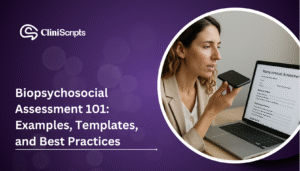Mastering the Mental Status Exam (MSE): A Step-by-Step Breakdown for Clinicians
The Mental Status Exam (MSE) is a crucial tool for clinicians, providing a thorough evaluation of a patient’s cognitive abilities and emotional well-being. Whether you’re in psychiatry, neurology, or primary care, getting a good grasp of the MSE can really boost your diagnostic skills and help shape treatment plans. In this blog post, we’ll dive deep into the MSE, breaking it down into easy-to-understand sections and sharing practical examples to enhance your knowledge and expertise.
What is the Mental Status Exam?
The Mental Status Exam is a structured way to assess different aspects of a patient’s mental functioning. It includes:
- Appearance: Taking note of how a patient presents themselves.
- Behavior: Observing their general demeanor and actions during the exam.
- Speech: Looking at the form, speed, and clarity of their speech.
- Mood and Affect: Gaining insight into the patient’s emotional state.
- Thought Process: Evaluating how organized and fluid their thoughts are.
- Cognition: Checking their orientation, memory, and focus.
- Insight and Judgment: Understanding their awareness of their situation and how they make decisions.
Conducting a thorough MSE goes beyond just ticking boxes—it demands active listening, keen observation, and thoughtful analysis.
Step 1: Establish Rapport
Before you jump into the exam, it’s really important to build a connection with your patient. When there’s trust, it opens the door for honest communication, which is key for making an accurate assessment. Here are some tips to create a friendly atmosphere:
- Start with some small talk: Chatting about light topics can help ease any nerves.
- Show empathy: Let them know you understand their feelings and worries.
- Be patient: Allow them the time they need to share their thoughts without feeling hurried.
Establishing a good rapport lays the groundwork for the rest of the examination.
Step 2: Appearance and Behavior
The first observational aspect of the Mental Status Examination (MSE) involves looking at the patient’s personal grooming, hygiene, and overall demeanor. Here are some key points to consider:
- Dress: Is the patient dressed suitably for the weather and the situation?
- Body Language: Are they showing signs of anxiety, restlessness, or perhaps withdrawal?
- Eye Contact: Are they engaging in eye contact or avoiding it? For instance, a patient who looks disheveled might provide clues about their mental health, possibly suggesting issues like depression or neglect.
As a therapy aid, you can also take detailed therapy notes to keep track of these observations.
Step 3: Speech
Speech can offer valuable insights into a patient’s cognitive and emotional well-being. During this stage, keep an eye on:
- Rate: Is the patient talking too fast (which might hint at mania) or too slow (possibly indicating depression)?
- Volume: Are they speaking softly and hesitantly, or are they loud and confident?
- Coherence: Is their speech logical and easy to follow, or does it seem a bit off-topic?
A practical tip: Encourage the patient to share about their day or their thoughts, as this gives you a chance to evaluate their speech in a more natural way.
Step 4: Mood and Affect
The next critical aspect involves assessing the patient’s mood and emotional response. Similar to the previous steps, look for:
- Facial Expressions: Do their expressions match their reported feelings?
- Consistency: Is there alignment between their mood and affect during the conversation?
By understanding these elements, you can gain a clearer insight into their mental state.
Step 5: Thought Process
The way a patient organizes and expresses their thoughts can reveal a lot about their mental health. When conducting this assessment, pay attention to:
- Logical Connections: Are their thoughts connecting smoothly from one idea to the next?
- Content: Do you notice any obsessions, delusions, or rapid shifts in ideas?
Asking open-ended questions can really help you get a clearer picture of how their thoughts are structured. Utilizing mental health dictation services can also aid in efficiently capturing this information.
Step 6: Cognition
Cognitive evaluation often looks at how aware a patient is of their surroundings and their memory. Here are a few key areas to focus on:
- Orientation: Check in with the patient by asking them about the date, time, and where they are.
- Memory: Test their immediate recall by having them remember a few words you share during the exam.
- Concentration: You can assess their focus with simple tasks, like counting backward from 100 by sevens.
A practical tip: try to weave cognitive tasks into your conversation naturally. You might even consider employing therapy transcription services to document these exercises.
Step 7: Insight and Judgment
Finally, take a moment to evaluate how well the patient understands their condition and their ability to make decisions. You might ask questions such as:
- “What brings you here today?”
- “Can you explain your treatment options?”
A patient’s grasp of their situation can really show how actively they’ll participate in their own care. This understanding is key for mental health professionals aiming to create effective therapeutic interventions.
Conclusion
Mastering the Mental Status Exam is more than just a skill; it’s a journey that truly enhances your clinical abilities and makes a real difference in patient care. Each part of the exam builds on your overall understanding of the patient, helping you make informed decisions and provide the right interventions. By incorporating these steps into your practice, you’ll not only conduct more effective exams but also strengthen the therapeutic relationship with your patients, creating a space where they feel heard and appreciated. Keep in mind, the MSE isn’t merely a checklist. It’s a meaningful conversation that can unlock powerful insights into your patient’s thoughts and experiences, further supported by mental health transcription services to facilitate accurate documentation.










